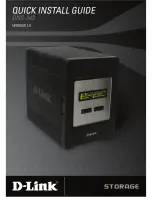
7914FDE.fm
Draft Document for Review March 28, 2011 12:24 pm
472
IBM System Storage DS3500: Introduction and Implementation Guide
The locked state will rarely be seen, that is, only when the array containing the disks have
been moved to another DS3500 or controllers have been replaced. The drive becomes locked
whenever the disk is powered down. The drive will remain unlocked during firmware upgrades
or while other components are being replaced. When the drive is powered on, the status will
be locked. If it detects a security key identifier, then it will remain locked until it has
successfully authenticated with the DS3500 Disk Encryption Manager.
15.4.5 Hot spare drive
If a disk drive fails in the DS3500 storage subsystem, the controller uses redundant data to
reconstruct the data on the failed drive on a global hot-spare drive. The global hot-spare drive
is automatically substituted for the failed drive without intervention. When the failed drive is
eventually replaced, the data from the hot-spare drive is copied back to the replacement
drive.
Hot-spare drives must meet the array hot-spare requirements. The following drive types are
required for hot-spare drives when secure-capable arrays are configured. If a drive does fail,
the Storage Manager automatically determines which hot-spare drive to substitute according
to the type of the failed drive:
For an array that has secured FDE drives, the hot-spare drive must be an unsecured FDE
drive of the same or greater capacity. After the unsecured FDE hot-spare drive is used as
a spare for a failed drive in the secured RAID array, it is security enabled.
For an array that has FDE drives that are not secured, the hot-spare drive can be either an
unsecured FDE drive or a non-FDE drive.
An unconfigured secured FDE drive cannot be used as a global hot-spare drive. If a global
hot spare is a secured FDE drive, it can be used as a spare drive only in secured arrays.
15.5 Migrating secure disk arrays
This section will detail how to migrate an array with Disk Security enabled to another DS3500.
The process consists of exporting the array on the source DS3500 and importing the array on
the target DS3500 after the disk have been physically moved. User data remains intact on the
disks because configuration metadata is stored on every drive in the DS3500. The export
process is the same as an ordinary array, but there are some extra steps to be carried out for
the locked drives of the secure array when importing.
15.5.1 Planning checklist
This list is displayed in a window of the migration wizard (Figure 15-25 on page 474). It is
important to follow this list when planning an export and import of an array.
On the source DS3500:
Save the DS3500 configuration by selecting Storage Subsystem
Configuration
Save.
Back up all data at the host level on logical drives of the array.
Ensure that all I/O has been stopped to the array, and unmap any logical drives that are
mapped on the array, ensuring that each host no longer requires the disk presented to it by
the array to be migrated.
Locate the array disks on the DS3500, noting the enclosure ID and location slot of each
disk member.
Summary of Contents for DS3500
Page 2: ......
Page 5: ...iii Draft Document for Review March 28 2011 12 24 pm 7914edno fm ...
Page 789: ......
















































